Cape Town to Cairo 2012
Day 3 to Day 8 - May 31st–June 5th
We arrived in Namibia on May 31st and immediately rode past a squatters’ town that was like a mobile home park made of cardboard boxes.
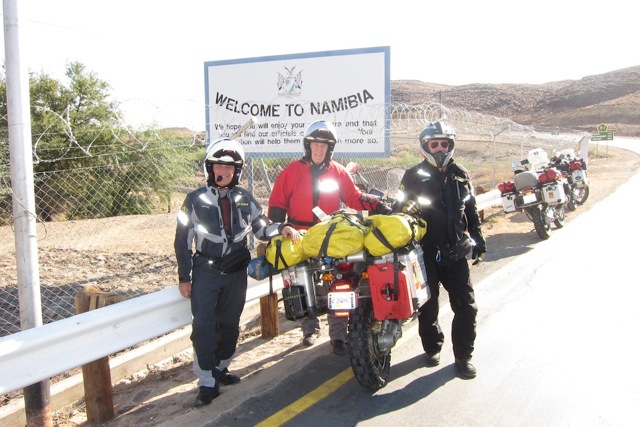
Namibia has an unusually large disparity between the “haves” and the “have-nots.” In the background of this photo, the shacks are in barren desert.
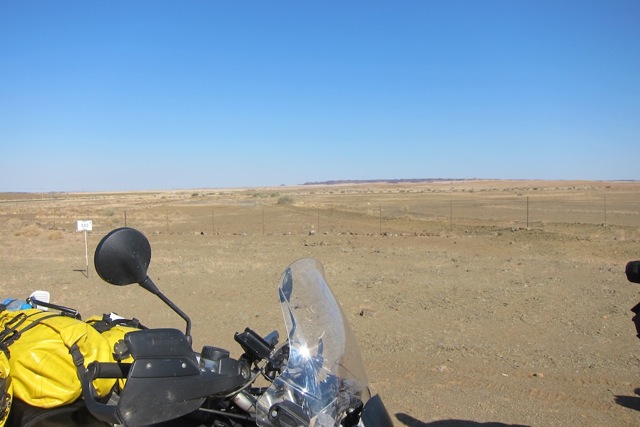
We will be off-roading from now on, so we lowered our tire pressure to 30 lbs. We had our first experience with riding on loosely packed gravel and sand. It was rough going, but arriving at the beautiful lodge made it all seem worth it.
Flotsam and jetsam by the pool:
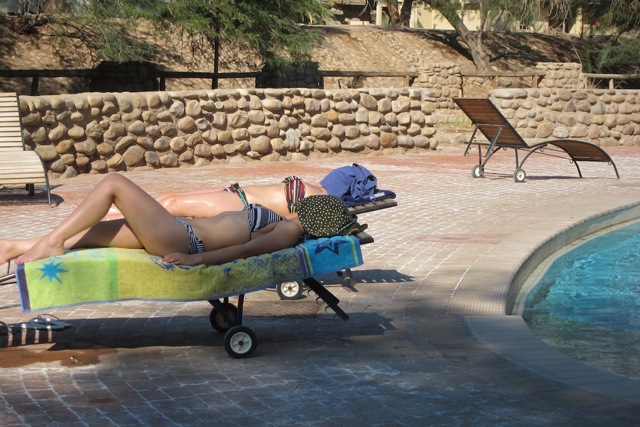
I’m having major problems with my camera system. I have cameras mounted on my helmet, pointing to the front and back, but the system has a tendency to turn itself off at very inopportune times. On one occasion there was an ostrich running alongside me only five feet away. He was thinking about crossing in front of me but didn’t have the nerve. I thought I was capturing this on film but it didn’t work out. So frustrating. We took a ride out to Fish River Canyon. Compared to the Grand Canyon, the geologic formation is small, but it is rather dramatic. The canyon was formed by the movement of tectonic plates when Africa and South America were still one continent; later, the canyon was further eroded away by the Fish River, which now flows intermittently in late summer.
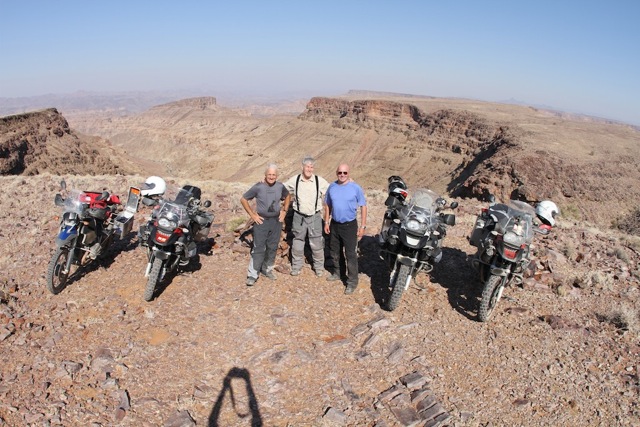
We spent two days at Canyon Lodge and had some interesting off-road riding studded with big rocks and variable conditions—a perfect way to practice for the dirt, sand and rutted roads that will follow.
We stopped at a lovely restaurant along the way with lots of antique cars.
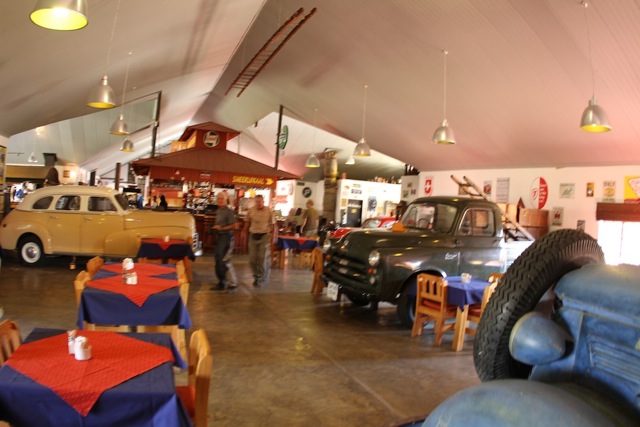
When the box on this poster is opened, a loud alarm sounds in the restaurant so that diners can see the inappropriate gentlemen leaving the bathroom in a walk of shame.
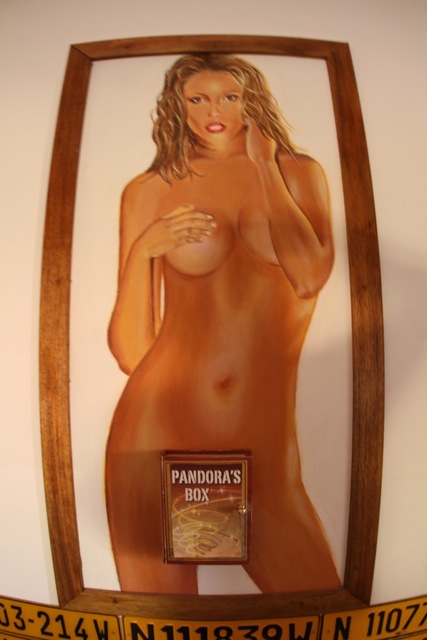
We left Canyon Lodge and moved on to Sesriem, where we stayed at a fancy eco-lodge.

We covered 300 miles on a rutted dirt road—truly a come-to-Jesus experience. When moving fast, the motorcycle’s front tire catches the sand and pulls the wheel. Inevitably, you are following a track left by cars with gravel piled up on either side. We have to be tense at all times.
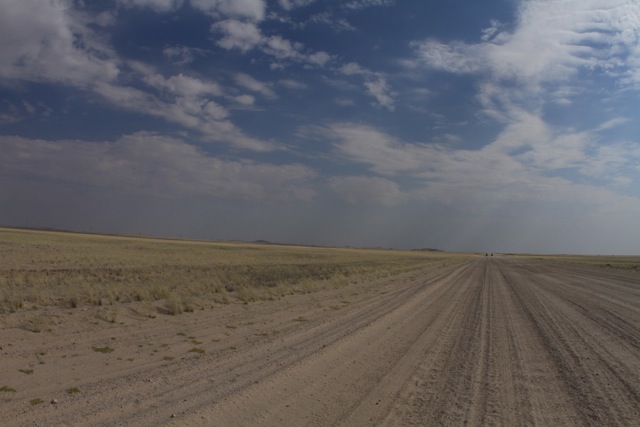
Riding roads like these reminds me of the old adage about sled dogs: “For the dogs in back, the scene never changes.” Here you have to concentrate so much on the road that you cannot look around you. If an enormous large-toothed predator decided to leap at us out of the desert, we wouldn’t see it coming.

At Sesriem, we saw the world’s largest dunes. “Big Daddy” is 1200 feet high.
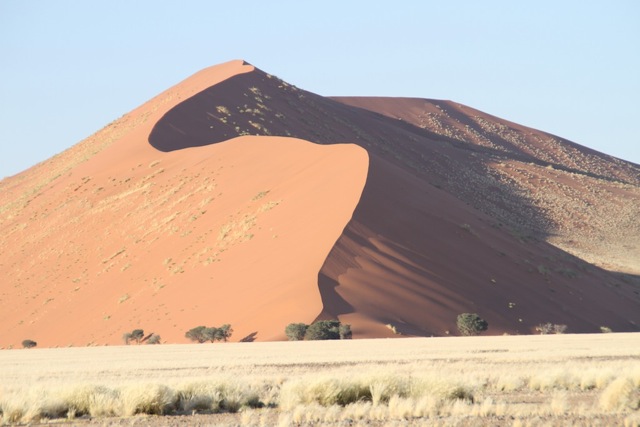
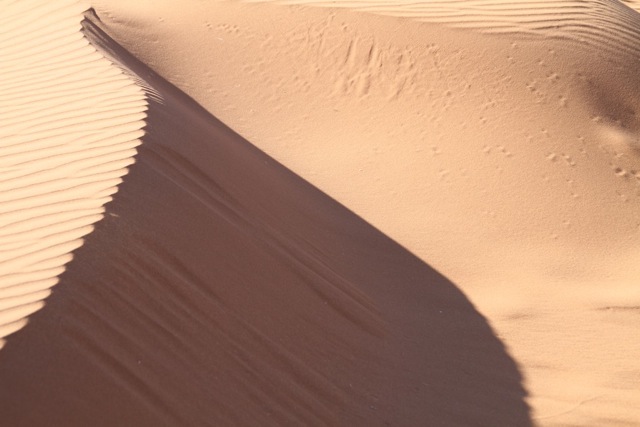
We hired an airplane so we could look down on the dunes, which run all the way from Sesriem to the Atlantic, a distance of perhaps 60 miles.
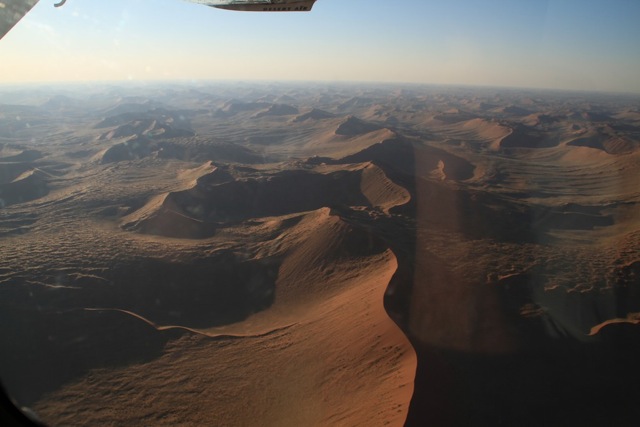
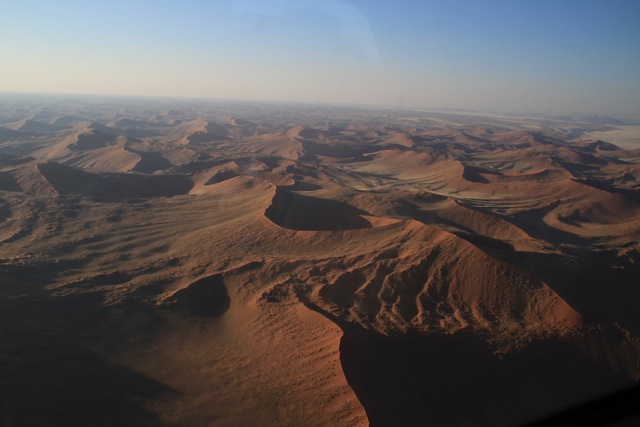
The wind typically blows from the east and creates a very dry environment. Namibia has had five years of drought, but this year they got almost twice their average rainfall. As a result, in some parts of the country the foliage is full. Although we saw a lot of animals, we were told that they were not as prevalent in populated areas because the abundance of foliage draws them away.
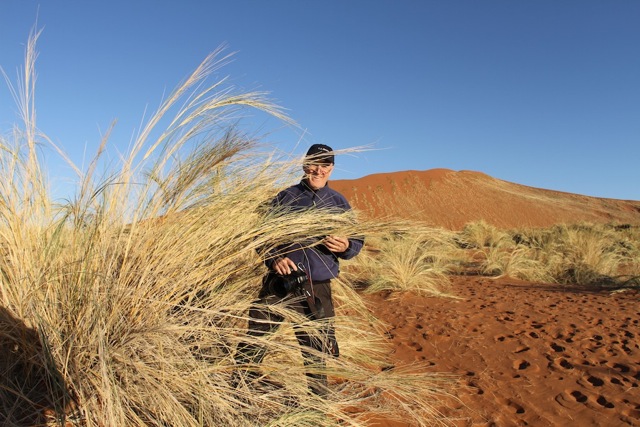
In parts of Namibia, the grass looks like a wheat field in Kansas.
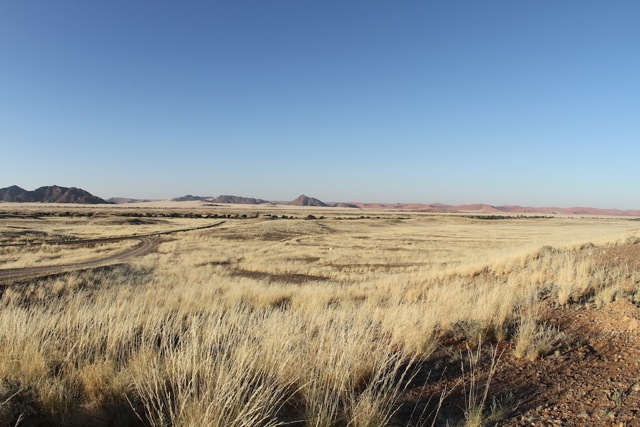
On the way to the dunes, we saw ostriches.
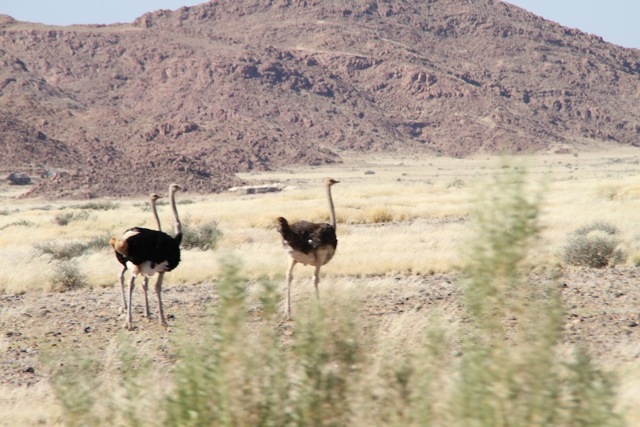
In a fascinating nest was a large colony of weaver birds. The nest was approximately 10’ x 10’ and had hundreds of birds in it. The birds, which are similar to sparrows, build and maintain these really multi-chambered nests for years—some nests could be a hundred years old. The nests are constructed of many rooms that serve different purposes—a nursery for chicks, for example, which would be insulated best to protect from the intense heat and cold of the desert.
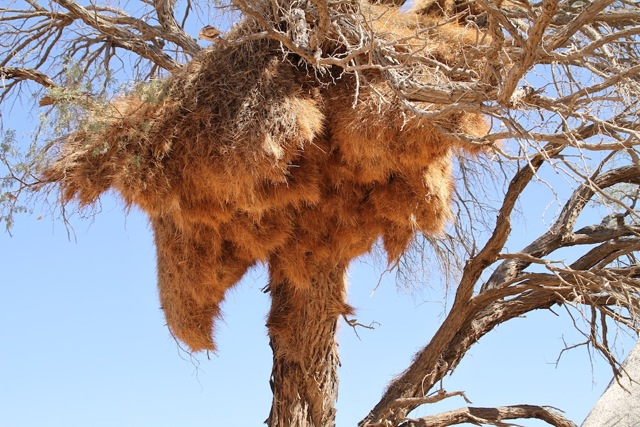
When we left for the Atlantic coast, we ran into the same unstable road conditions: patches of soft gravel and sand.
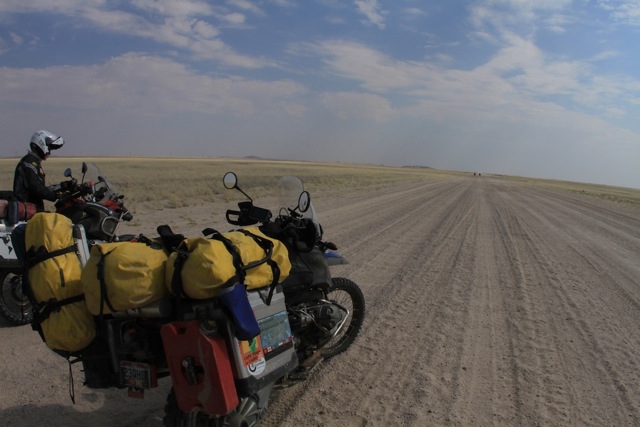
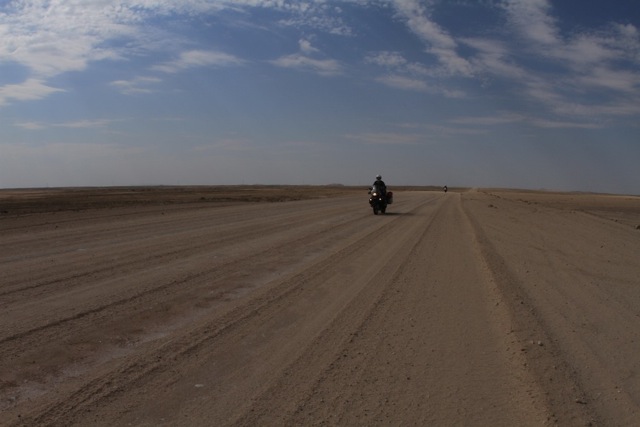
On the way we met a cute couple—a French boy and a Japanese girl who had just finished college. They were peddling their way to Japan on a bicycle!
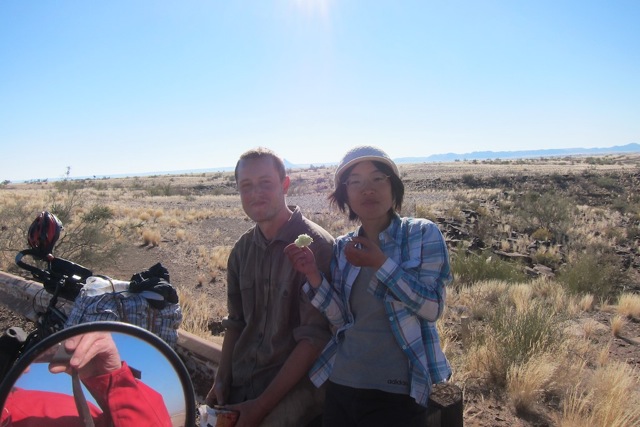
At this point, we passed the Tropic of Capricorn.
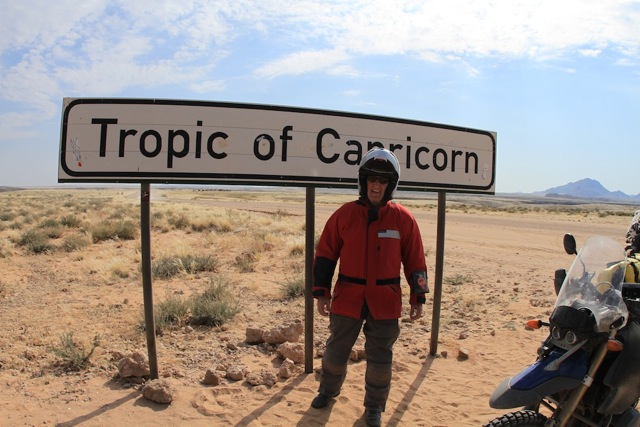
We had breakfast with this cook. His big dream is to get a Harley Davidson chopper and weld it together himself. I think he’s been watching too much TV, but his bakery was spectacular.
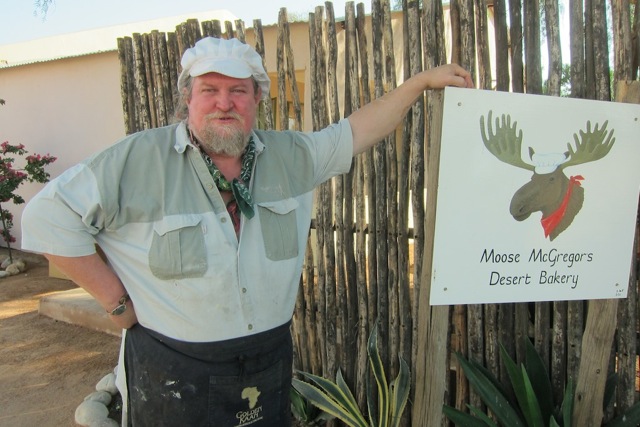
On the afternoon of June 5th, we arrived at Swakopmund, a resort town on the Atlantic coast of Namibia. We saw a beautiful waterfront with nice restaurants and lovely shopping areas but intense poverty surrounding it. The city, which was the main harbor for the imperial German colony in the 1890s, has been furthered developed because of the infrastructure demands made by the world’s largest opencast uranium mine in Rössing, 70 km away.
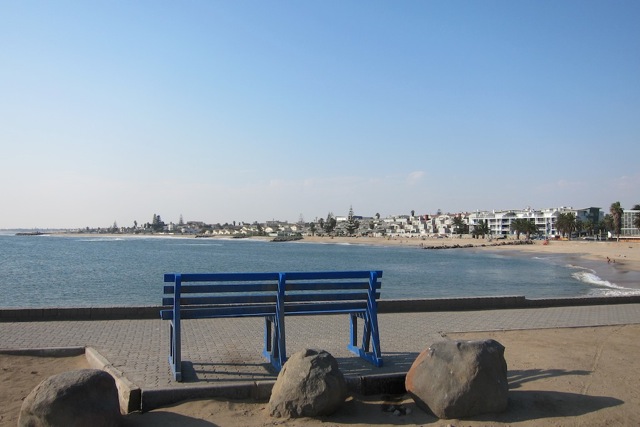
Tomorrow, we leave for the Rhino Camp Road, which is over 300 kilometers over horrible dirt roads. We are trying to talk Helge into renting a car to haul our luggage to lighten up the weight on our bikes, but he is resisting and we’re not making much progress!
That’s all for now.
Back to Top

- Gravel roads
- dfasdfs
- Air Jordan Donna outlet
- cheap pandora sale -
January 2, 2018, 8:20 am
- Hammer Of Thor Asli Di Medan
Add A CommentWalter Maurer - June 7, 2012, 6:31 am
Dan, Sounds like the roads are a lot like Ruta-40 in Argnetina on the way South to Tierra del Fuego. Ride safely.
fasd - June 24, 2017, 8:40 am
This is a story of the Pandora charm websitecheap pandora
Air Jordan Donna outlet - July 19, 2017, 8:11 am
Scarpe da corsa Nike scarpe, ti permettono un esercizio confortevole, Air Jordan Donna outlet meriti di avere, cosa stai aspettando?scarpe nike outlet Scarpe da corsa Nike, super pratico!
Buy cheap Pandora Jewelry,pandora Charms,pandora Rings pandora Bracelets from pandora Factory outlet Store;Selection cheap Pandora charms as special gift for your wife or girlfriend, mom, daughter.Welcome to pandora replica store .All pandora are more than 63% discount.Pandora online store offer pandora rings,beads,necklace,charms pandora sale pandora outlet UK online Store.Cheap pandora Jewelry Sale at pandora outlet online Store. Find A Great Selection of pandora Necklace & Bracelet,Rings.
rumah herbal - March 13, 2018, 6:10 pm
thanks for the article which is very useful, with this post possible for myself and others can add a little insight into what you describe through this blog, even for an author of this blog include people who are good personality throughout his life because it can bring guests from various other parts of the world not just to be a special guest at this very interesting blog.
Obat Titan Gel Asli Di Palembang
Obat Anabolic Rx24 Asli Di Palembang
Obat Kuat Forex Asli Di Palembang
Obat Viagra 100mg Asli Usa Di Palembang
Obat Kuat Cialis 80mg Asli Di Palembang
Obat Potenzol Perangsang Cair Di Palembang
Obat Blue Wizard Perangsang Cair Di Palembang
Jual Obat Hercules Cair Di Medan
Obat Pelangsing Green Coffee Bean Di Medan
Obat Erogan Asli Di Medan
Alamat Hammer Of Thor Di Medan
Testo Ultra Di Medan
Jual Cream Develope Sex Asli Di Medan
Obat Hermuno Intoxic Capsul Herbal Anti Parasit
Distributor Obat Titan Gel Asli Di Medan
Produk Pusat Anabolic Rx24
Jual Obat Capsul Forex
Toko Vimax Asli Di Medan
Pusat Obat Kuat Viagra 100mg Asli Di Medan
Jual Cialis 80mg Obat Kuat Asli Di Medan
Jual Semenax Asli Obat Penyubur Sperma Di Medan
Tattonox Obat Penghilang Tatto Di Medan
Jual Selaput Dara Buatan Asli Jepang
Alat Bantu Vagina Center Flashlight Di Medan
Jual Vagina Getar Suara Silicon Di Medan
Boneka Cantik Full Body Silikon Asli Di Medan
Jual Penis Getar Goyang Alat Bantu Sex Wanita
Jual Penis Mutiara Getar Putar Di Medan
Jual Penis Ikat Pinggang Alat Bantu Sex Wanita
Toko Penis Tempel Jumbo Silicon Di Medan
Distributor Kondom Sambung Jumbo Di Medan
Distributor Kondom Duri Silicon Bergerigi Di Medan
Jual Kondom Getar Silicon
Jual Vakum Alat Pembesar Penis
Jual Alat Pro Extender Asli Alat Terapi Pembesar Penis
Jual Viagra Asli Usa 100mg Obat Kuat Pasutri
Jual Kianpi Obat Penggemuk Badan
Jual Grow Up Asli Di Medan
Cream Titan Gel Asli Di Bekasi
Jual Titan Gel Asli Di Jakarta
Alamat Hammer Of Thor Di Medan
Obat Ericfill Asli Di Medan
Obat Titan Gel Di Surabaya
Obat Anabolic Rx24 Di Surabaya
Obat Forex Asli Di Surabaya
Obat Viagra 100mg Asli Usa Di Surabaya
Obat Cialis Asli Di Surabaya
Obat Potenzol Di Surabaya
Obat Blue Wizard Di Surabaya
Obat Hercules Asli Di Medan
Obat Pelangsing Asli Di Medan
Obat Kuat Erogan Asli Di Medan
Obat Forex Asli Di Medan
Obat Vimax Asli Di Medan
Obat Viagra Asli Usa Di Binjai
Obat Cialis Tadalafil Di Medan
Obat Blue Wizard Asli Di Medan
Obat Potenzol Asli Di Medan
Add A Comment